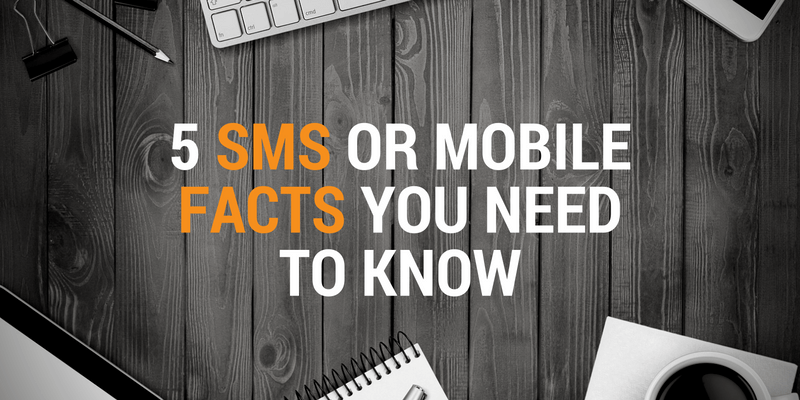5 SMS or Mobile Facts You Need to Know

So many of us are used to having our mobiles around nearly 24 hours a day that it’s easy to forget it’s still a growing industry. And though SMS has been around for over two decades, the ways we use it and people’s willingness to use it continue to grow. So for this blog I picked out five facts about mobile communications and SMS messaging that really make the case that SMS for business has come of age. Let’s see if you agree.
- People value their mobile more than pleasure. This one sounds kind of crazy but when asked what people would give up to keep their phone people were willing to part with simple pleasure items before giving up necessities. Here’s what they would be willing to forgo:
- 70% alcohol
- 63% chocolate
- 33% sex
The next item people in the survey would give up is their toothbrush, but 22% would still go that far!
- SMS messages get read faster than emails. According to SAP, 76% of respondents to their survey say they will read a text message sooner than an email. If you want your message to get noticed quickly, SMS is the way to go.
- People like getting text messages from organisations. In SAP’s survey 70% felt SMS messaging is a good way for organisations to get their attention. Another 64% thought businesses should use SMS more often to communicate with them. More and more people are becoming comfortable with text messaging as a main form of communication. Why not take advantage of that?
- Relevant SMS marketing can increase sales. In an Ipsos observer survey 64% of people said they’d made a purchase based on a text message they received that had a relevant offer for them. These consumers were already subscribed to mobile marketing from the companies involved. Email can only dream of reaching response rates like that.
- A variety of offer types work well. Whether you send a price based, time sensitive, or location based offer, your response rates will still top 50%. The Ipsos observer study showed 66% of people will act on a price based offer, 52% to time sensitive offers, and 50% to location based offers. No matter how you look at it, those are awesome response rates.
So what do you think? Can we say SMS marketing is hitting its prime or is it still just beginning? Take a look at our Mobile Marketing Guide for more ideas.
Related Articles
Have IM Apps Made SMS Messaging Irrelevant?
Earlier this year there was big news. WhatsApp users were sending more messages each day than SMS users were sending. According to the Telegraph, WhatsApp was 50% more popular than SMS messaging. And the truth is the number of SMS messages sent each day has declined over the last few years. In the UK it was down almost 25% from 2012 to 2013. But is that the whole picture?
Email vs. SMS Revisited
The digital marketing age has really given us so many options when it comes to running campaigns. If you Google “digital marketing channels”, you’ll get article after article about which ones work the best. Of course, most of them won’t completely agree. Here we take another look at how email and SMS measure up against each other.
4 Basic Metrics for Your SMS Marketing Campaigns
One key to successful marketing is to know when you’re doing it right. And when you’re doing it wrong. The great thing about SMS marketing is you can get that information pretty quickly. But to understand how your messages are performing, you need to do a little maths. Thankfully, it’s all rather simple once you see it.
UK digital advertising spending tops 7.4 billion euros
3 Tips to Help You Time Your SMS Marketing Campaign
Timing is everything. While it’s an axiom everyone can understand and agree on, it’s doubly true when it comes to SMS marketing. If you send your messages at the wrong time, you’ll see your opt out rates jump and your ROI plummet. So when should you send your text marketing messages? Here are three key guidelines to help you schedule your next campaign.
12 Reasons Mobile Messaging is “A Beautiful Thing”
Beauty is in the eye of the beholder. But could text messaging really be considered beautiful? You might argue that it depends on the messages you get! That’s a valid approach, but I recently found a description of mobile messaging that made me believe it is indeed beautiful, so I thought I’d share it with you.
Salesforce Finds SMS Messaging a Growing Part of Mobile Marketing Strategy
What do 5,000 marketers from ten different countries say about SMS? It’s great, and we’re going to do more of it. Well, that’s the gist of the results in the Salesforce 2015 State of Marketing Report. Mobile marketing has taken a central place in most company’s strategies, and SMS is a growing part of it. Here are some key statistics from the report.
3 Reasons SMS Messaging is Good For The Environment
Many organisations are looking to operate in a more environmentally friendly way. This includes everything from their office supplies, materials used in creating their products, and also choosing suppliers and vendors that are also environmentally aware. And now, SMS.
SMS Messaging is Much Better Than Shouting!
Just in the last 60-70 years, communications have gone from requiring a person to route the calls to not needing anyone other than the two people at either end. It all got me wondering about the history of communications and how much different it is from even just a 100 years ago, or a thousand. The result of my wondering is this infographic that covers most of recorded history (at some level of detail anyway).
5 SMS Myths You Shouldn’t Believe
SMS messaging is a popular topic. The growth of mobile has everyone jumping on board the SMS waggon and they all have something to say. I've compiled a list of five topics that I've seen written about that just aren't true, or at the very least are potentially misleading enough to be called myths. I'm going to try and offer some insight into why these myths exist and what the truth is, as I see it anyway!












